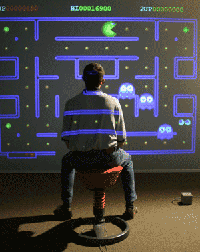Case Study: Users Can Use Their Body To Navigate Using ChairIO, for Virtual Environments
The chairIO is a hands-free travel interface used in Virtual Environments (VE) where the body is used to navigate. This is a project that has been developed by the interactive media/virtual environment group which was founded in February 2004 at the University of Hamburg, Germany. It is part of the department of informatics. Three scientists and several students work on projects , teach and learn in the areas of human-centered Human-Computer Interaction, Computer Graphics, Virtual Environment Systems and Technology, Interactive Storytelling, and Art. The Polhemus PATRIOT motion tracking system was used for this application.
Navigation is one of the most important tasks in VE. The chairIO project is an interface based on a commercially available seat, the Swopper™, and the Polhemus PATRIOT, a two-sensor motion tracking product. The Swopper stool is an ergonomic seat for use in an office environment. It has a rotatable seat, 360º pivot point, height and damping adjustment, and a linkage arm consisting of a spring/shock combination. The seat can tilt in any direction and the spring/damper system allows the user to bounce. The seat itself is on a rotational system on top of the linkage arm, allowing it to independently rotate.
 To operate the chairIO, the user sits on the device and, by shifting body weight, tilts it in any direction or rotates the seat. This physical movement of the seat is mapped to viewpoint/direction movement in the game environment. For example, the sensation of forward movement is achieved by moving your body forward and tilting the seat forward. Rotating the view requires slightly rotating the seat, thereby triggering slower or faster rotation of the view in that direction.
To operate the chairIO, the user sits on the device and, by shifting body weight, tilts it in any direction or rotates the seat. This physical movement of the seat is mapped to viewpoint/direction movement in the game environment. For example, the sensation of forward movement is achieved by moving your body forward and tilting the seat forward. Rotating the view requires slightly rotating the seat, thereby triggering slower or faster rotation of the view in that direction.
For a 3D ground-following movement, this method is easy and highly intuitive to use and, furthermore, is fun. The movement is computationally divided into the component translation and rotation. Translation of the current viewpoint is performed by tilting the seat in any direction and translation speed is non-linearly mapped in relationship to how far in the direction of the desired travel the user tilts the stool.
In an area surrounding the center the mapping is linear; thereafter, the distance is mapped as linear plus a cubic factor. This allows the user to travel at higher speeds by tilting the seat further in the direction of travel.
The PATRIOT determines the position and orientation of the seat using two points on the seat. This method was chosen primarily for its robustness in initializing the interface, as it is not position dependent and allows re-adjustment of the seat's height and of the seat itself. An initialization procedure sets a few values used in the calculation, such as the rotation of the seat and the position of the Swopper.
Based on these variables the PATRIOT provides the translational component from the initial position. The rotation of the seat is calculated by applying the inverse tilt transform to the seat and comparison with the initial rotation. Future plans include integrating low-price standard sensors into the chair.
The software written to connect the interface to Linux or Windows® applications makes use of VRPN. For Windows, PPJoyis was used to present the chairIO data as joystick data to applications.
Learn More:
- PATRIOT
- Download PDF
- Contact sales@polhemus.com
For more information on University of Hamburg chairIO project please visit http://imve.informatik.uni-hamburg.de/projects/chairIO/index.htm.

